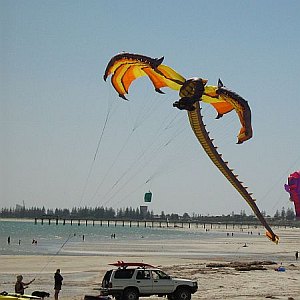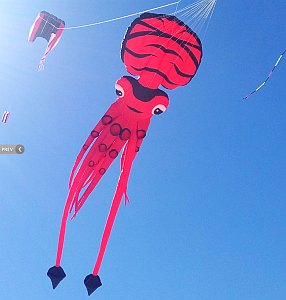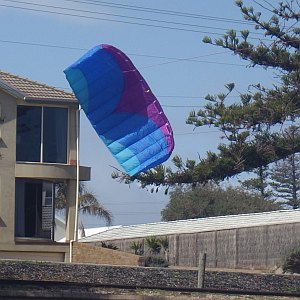3D Kite Zoo!
All Types Explained
So what's a 3D kite, exactly? Traditionally, when you heard "kite," mainly single-surface designs came to mind. Even those leading-edge
inflatables that kite surfers use are single surface.
For many decades, the most well-known non-flat concepts were various types of box kite and the Chinese centipede-style dragon. But hey, things have moved on! Have you been to a kite festival lately and seen the huge inflatables? Very 3D.
On this site, there's more kite-making info than you can poke a stick at :-)
Want to know the most convenient way of using it all?
The Big MBK E-book Bundle is a collection of downloads—printable PDF files which provide step-by-step instructions for many kites large and small.
Every kite in every MBK series.
Categories of 3D Kites

In the latter part of the 20th century and continuing into the 21st, there has been an explosion in 3D designs of many types, rigid and soft.
Down below I have attempted to categorize them all with some illustrative photos from my own experiences.
It really helps to have an annual kite festival on your doorstep! Note
that AIKF is an abbreviation for the Adelaide International Kite
Festival.
Rigid Objects
There are so many of these, a few subcategories are necessary!
Creature Kites
Usually, the wings are single surface, and light materials are used to hold a 3D form for the body. Dragons, birds, sea creatures, or insects can be subjects. Anything with wings that occurs in mythology or in real life is fair game for making a 3D kite! Construction methods for the 3D body include thin paper-mache, a bamboo framework covered in paper, or a fiberglass-rod frame covered in ripstop nylon.
Here are some particularly well-known examples:
- Retail kids' kites like the 3D Shark and 3D Dragon
- "Bali kites" of various birds, featuring collapsible bamboo frames and paper-mache bodies
- Chinese replicas of ancient designs, like the swallow kite, in molded bamboo strips and paper
A country town called Murray Bridge (just outside our city) put on a kite festival once, and that's where I spotted the 3D dragon in the photo below. The Bali eagle came into my possession after a club-storage cleanout and reorg one weekend. On a slack line, the bird can look quite realistic in flight.
 Dragon kite at a country festival
Dragon kite at a country festival My Bali eagle
My Bali eagle
Simple Sculptures
Sometimes, these are vehicles that are meant to fly, like aircraft of various types. Conveniently, they have wings :-) But also, novelty designs like ship kites come under this category. Again, we saw one at Murray Bridge. There's an element of humor in there when you see something aloft that really shouldn't be flying!
A site visitor once contributed a story about a 3D kite of his—a box design in the form of Snoopy riding a kennel :-) The thing was airworthy, and there's a photo of it below.
 Ship kite seen at a country festival
Ship kite seen at a country festival Snoopy flying kennel (box kite)
Snoopy flying kennel (box kite)
Artistic Composites
In Bali, there's something very special going on in kite making. It's the Kreasi Baru (New Creation) category of competition at the incredible Bali Kite Festival. The things these people come up with—and it has to be airworthy of course! The main criteria is that the kite must be conceived and constructed in the previous 12 months. Apart from that, anything goes! It doesn't have to be a 3D kite, but of course they look the best.
 A Creasi Baru entry
A Creasi Baru entryI've seen images from the festival of such things as an ox and cart,
people seated at a table, a piece of cursive writing (in 3D!) and so on.
No real categorization is possible other than terms like my title up
there (Artistic Composites) or perhaps Flying Sculptures.
The artist imagines just about anything that comes to mind. And who says it even has to be symmetrical. The next step would be to build it light enough, then experiment with bridling and perhaps tails until the thing flies!
Of course, there would be some consideration given to what elements of the creation would serve as lifting surfaces. I can imagine some prototypes would flat-out fail, and the kite artist would simply take a different tack or tweak some components and try again. Truly, it's kite making at its most creative!
Soft Objects
The overwhelming majority of these are creatures of one sort or another—everything from fish to humans! There was even a combination of those two—the mermaids ;-)
This is possibly the most visible and popular category of large show-kites today. We see plenty of them at the AIKF each year. These are not all true kites though:
- 3D kites like the octopus, squid, or trilobyte can fly unassisted, having plenty of lifting area and effective tails. A lifter kite right at the top is sometimes useful if conditions aren't perfect.
- Semi-flying inflatables like dolphins, frogs, and geckos make a contribution to lifting the flying line. However, a pilot or lifting kite is required right at the top, just to keep things steady!
- Non-flying inflatables like tall, narrow fish are just there for looks, hanging from the line.
Here are some photos we have taken at the AIKF in previous years:
 Inflatable dragon at AIKF
Inflatable dragon at AIKF Inflatable squid at AIKF
Inflatable squid at AIKF Inflatable whale at AIKF
Inflatable whale at AIKFOccasionally, someone will turn up with a smile-cracking novelty inflatable. Just about any crazy object you can think of is a candidate for hanging off a kite line! If it inflates in the breeze, all that is left to do is to suspend it from two points so it remains aligned into wind. Of course, these things are not true kites if they don't develop any lifting force.
Rigid Cellulars
This includes the simplest of box kites, right up to amazingly complex art designs featuring dozens of individual cells and flat surfaces. With all those individual elements, there's plenty of scope for cleverly artistic arrangements of colorful patterning.
Apart from the simple traditional square box which nearly everyone can recall seeing in books, the next most recognizable cellular design would have to be the Cody. We've seen a few great Cody kites at the AIKF. When constructed with carbon spars and a light grade of ripstop nylon, these kites are great flyers over a large wind-range. See the photo below.
Another popular cellular 3D kite is the star, with plenty of very individual designs popping up online as people share their large and elaborate creations. A friend of mine flies his retail star at a local park and that's it below.
 My MBK Multi-Dowel Box
My MBK Multi-Dowel Box Cody kite at AIKF
Cody kite at AIKF Retail star at local fly
Retail star at local fly
Soft Cellulars
These are all ram-air kites. The air enters at the front of each cell, pressurizing it into a rigid state. The cells may be closed at the downwind end, like pure parafoils or kites based around a parafoil. Or, the cells may be open as is the case with flowform kites. A former president of our kite club flew a large panda flowform, which you can see in the photos below.
Where do I start? There are so many of these! OK, the most visible single-line designs would be the large but relatively simple four-cell lifters used to hang elaborate inflatables and other "line laundry." Our local kite club hangs out at a beach location each month, so there's a photo of one of these lifters (or "pilot kites") below.
That's single line. Multi-line kites are very popular, and a large proportion of these are "foils." Steerable parafoils in other words, like the blue sport-kite in the photo. At the club fly day we tend to pull out the steerable kites when the breeze is too fresh for our single-liners :-) With their double-surface construction and overall curved shape, these soft sport kites are surely 3D despite never being advertised as such!
 Panda flowform
Panda flowform Peter Lynn Pilot
Peter Lynn Pilot Dual-line foil
Dual-line foil
Centipede Kites
In a class of its own really, this Chinese invention is a somewhat flexible arrangement of individual rigid elements. OK, in English ;-) ... it's a 3D head with a tail of many small flat kites anchored to twin lines. The most well known of course is the giant dragon. See the photo down there! However, much smaller versions exist and are shipped out of China to customers in the West.
 Large traditional Chinese dragon
Large traditional Chinese dragonPhew! I got a bit carried away with all that. There's too many types of kites out there :-| I trust you feel a little more kite-educated though.
As mentioned earlier, there's more kite making on this site than you can poke a stick at. :-)
Want to know the most convenient way of using it all?
The Big MBK E-book Bundle is a collection of downloads—printable PDF files that provide step-by-step instructions for many kites large and small.
That's every kite in every MBK series.
